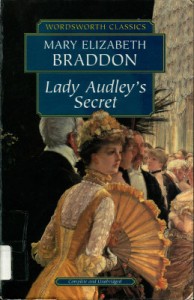 By Mary Elizabeth Braddon
By Mary Elizabeth Braddon
Wordsworth Classics
Lady Audley’s Secret is apparently an example of ‘sensation fiction’ – ‘a genre that flourished in the 1860s’ according to Catherine Wells-Cole who writes the introduction to this edition. Sensation fiction catered to the Victorian interest in ‘the lurid, scandalous and melodramatic’. Lady Audley’s Secret certainly has melodramatic elements and it does deal with potentially scandalous material such as bigamy, murder and blackmail. But, by these criteria, Charles Dickens and Charlotte and Emily Bronte would also be writers of sensation fiction. Nevertheless Lady Audley’s Secret was incredibly successful in its day and never out of print during the lifetime of the author. It was first published as a magazine serial and this shows with some pretty annoying padding in the third volume.
What’s particularly effective in the novel, and what raises it above the melodramas of the day, is Braddon’s use of ironic distance in the central character Lucy, the governess who becomes the second Lady Audley. Lucy is childlike, beautiful and everyone’s favourite, and appears to be genuinely fond of her aging, wealthy husband. The reader may not exactly warm to her (she is spoilt and given to a love of luxury) but she is not obviously a villain. The fun of the book is waiting for her to slip up as her husband’s nephew, Robert Audley, doggedly pursues answers to the disappearance of his friend George Tallboys, and begins to suspect Lucy has had a hand in it.
Braddon also has a way with words and I love her Gothic descriptions of Audley Court:
A fierce and crimson sunset. The mullioned windows and the twinkling lattices are all ablaze with the red glory; the fading light flickers upon the leaves of the limes in the long avenue, and changes the still fishpond into a sheet of burnished copper; even into those dim recesses of briar and brushwood, amidst which the old well is hidden, the crimson brightness penetrates in fitful flashes, till the dank weeds and the rusty iron and broken woodwork seem as if they were flecked with blood.
Needless to say the well does play a part in the denouement later on.
I did enjoy the novel, especially the detective aspects as Robert Audley (who is depicted in the early section as an amiable, lazy, pipe-smoking, dog lover and somehow morphs into an active and determined nemesis) runs around the countryside interviewing people and pulling burnt remnants of letters out of fireplace grates. I hoped that Robert would hitch up with Sir Michael Audley’s sharp and witty daughter but he goes, instead, for the po-faced, purer than pure sister of George Tallboys.
Perhaps Braddon gets away with the sensational aspects of the novel by framing them (more and more as the narrative advances) within a conservative moral framework. Robert goes from fop to staunch supporter of his Uncle’s honour, Lady Audley goes from clever schemer to a beaten, pathetic figure and the nasty, cold father of George Tallboys turns out to be an upstanding figure all along. Basically the male characters (except for some of the lower class ones – Lady Audley’s drunken father and the violent husband of her maid) come out squeaky clean in the wash and all the opprobrium is heaped upon Lady Audley. According to Robert Audley his friend George Tallboys is the best of men despite deserting his wife when she had just given birth to a child (he goes to make his fortune in the goldfields of Australia but he neglects to tell her that). Robert also thinks his uncle is something akin to a saint although he married Lucy when she was a governess and 21 years old, and then favoured her over his daughter of the same age. Of course Lucy takes over from the daughter in looking after the old codger.
I think there is a structural flaw in the novel in that it appears to come to a climax about two thirds of the way through and then tapers off before the final unravelling. Apparently Braddon wrote the last volume in two weeks and it shows. Nevertheless Lady Audley’s Secret is clever, often amusing, and Lady Audley’s depiction is an interesting example of an unreliable narrator (or at least unreliable character).

